How to perform a social media competitive analysis (+ free template)
Written by Carly Hill
Published on February 13, 2023
Reading time 10 minutes

They say self comparison is the thief of joy. But when it comes to social media, your channels don’t perform in a vacuum. You need to keep an eye on competitors to truly understand how your channels are doing and whether you stand apart.
Competitive analysis is more than just comparing yourself to others. And it’s definitely not about copying the competition. By analyzing the competition with a social media competitive analysis, you uncover valuable insights that empower you to improve your social strategy, and your entire business. After all, keeping an eye on the competition has cross-org benefits.
So how do you start? Don’t worry, we’ve boiled down the process into five simple steps.
How to perform a social media competitive analysis?
Before we start: Download our social media competitive analysis template to maximize the use of this article and make it even easier to follow these steps. We’ll be referencing this resource throughout the article to help you as you go.
1. Identify your social media competitors
Over half of respondents to a Gartner survey said choosing a well-known brand is less important than it was three years ago. Having a big, recognizable brand is no longer enough to stand out. But first, you need to know who you’re trying to stand out from.
Look to brands in your industry who are active on social media. These are brands whom you can learn from and benchmark against.
Your direct competitors on social are brands that sell the same products as you. Let’s use our fictional coffee company, Sprout Coffee, as an example: La Colombe, Peet’s Coffee, Caribou and local coffee shops are all direct competitors.
But also take note of indirect competitors. These brands may not sell the same product, but fill a similar need and reach a similar audience. For Sprout Coffee, that would be grocery stores or local cafes selling food and coffee.
How to ID your social media competition
For lack of a better term: Google it! Searching for the keywords consumers would use to find your business is one of the best ways to uncover competitors. For Sprout Coffee, you might Google “ground coffee” or “instant coffee.”
Look for websites that are in your specific industry. In our example, La Colombe and Folgers could be good options. Then, explore their active social channels. For instance, Peet’s Coffee is a popular coffee company that’s very active on social media, so it makes sense to add them to our analysis as well.
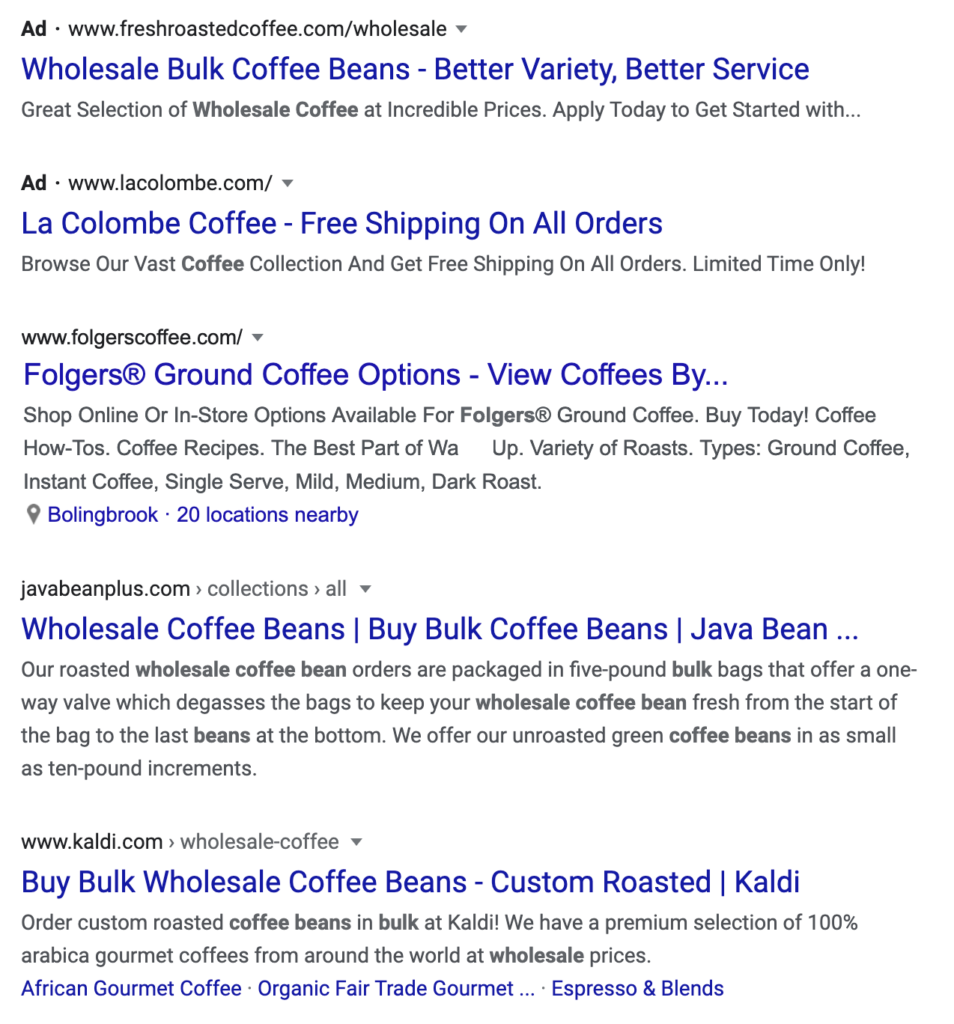
To get more specific to your audience, perform some market research or competitive monitoring. With social media listening, you’ll uncover conversations your audience is having about you, your industry and your competition—even when your handles aren’t tagged.
A powerful, all-in-one social media management platform
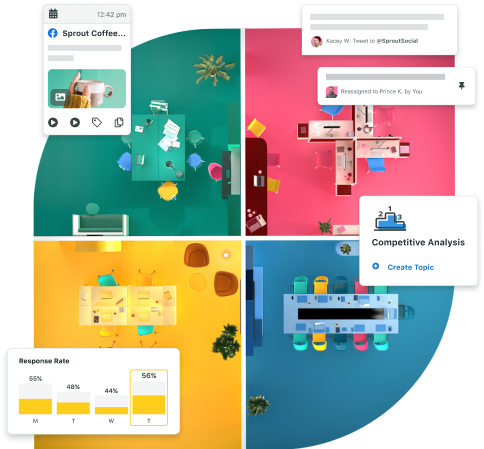
2. Gather platform-specific data
This is where social media intelligence comes in. Tracking how your competitors are performing on social requires you to look at each platform individually.
And this is not a one-and-done process. To keep your finger on the pulse of your competition, and to set competitive benchmarks, refresh this data quarterly or biannually alongside your larger social media reports.
This process can take a lot of time if you’re in a highly competitive industry. But the more thorough you are, the better results you’ll get. This is where a social media analytics tool is basically required.
Sprout’s competitive analysis tools provides you with a full, competitive picture. Combining the power of our Competitor Performance reports and listening tools, you’ll be able to aggregate your competitors’ social performance in one place for head-to-head comparisons and to help you understand your share of voice.
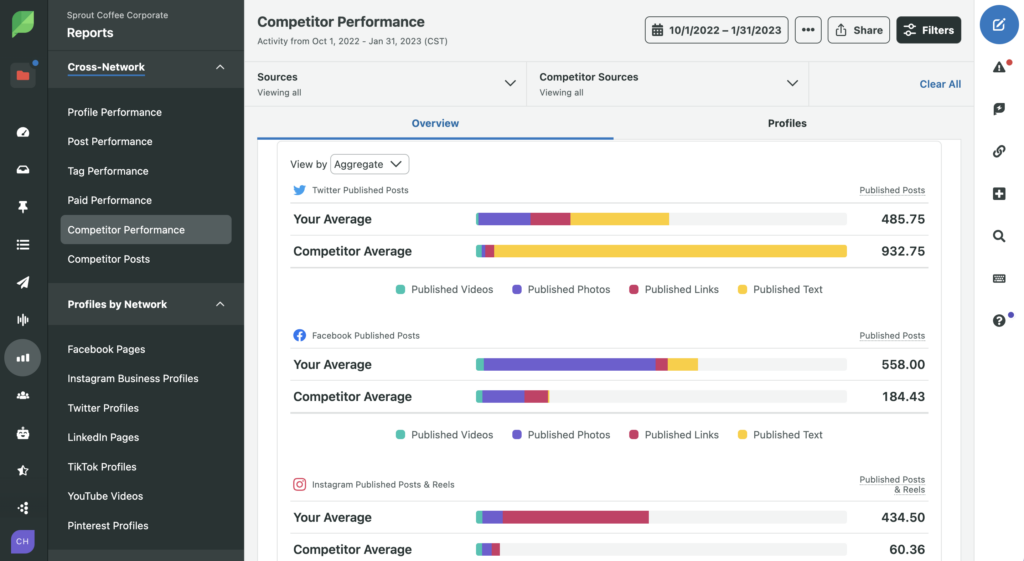
Let’s take a look at how to compare your brand to competitors’ social media presence on Instagram, Twitter and Facebook—the networks Sprout’s reports cover. Use these walkthroughs to guide what data you should pull for other networks too, like TikTok or LinkedIn.
Instagram competitive analysis
Start by doing a visual analysis of your competition’s Instagram account. Ask yourself:
- Do they use a link in bio tool? How often are they updating it?
- About how often are they active on stories? What does that content look like?
- Do they have a brand-specific hashtag?
- What do they say in their bio to set themselves apart?
- Are they using Instagram highlights?
Level up by using Sprout’s Instagram Competitors Report to compare and benchmark your brand against competitors at a glance in key areas:
- Audience growth: Are your competitors growing their audience quicker than you?
- Media sent: How frequently are your competitors publishing? This can reveal whether you’re posting enough to keep your audience engaged.

- Engagement: How many likes and comments does your competitor content get?
- Hashtags: What hashtags do your competitors use to gain more exposure?
- Top posts: Try to get an idea of why these posts are performing well. Are they product photos? Do they use certain colors? Find out what these posts have that your content doesn’t and use the info to improve your images and videos.
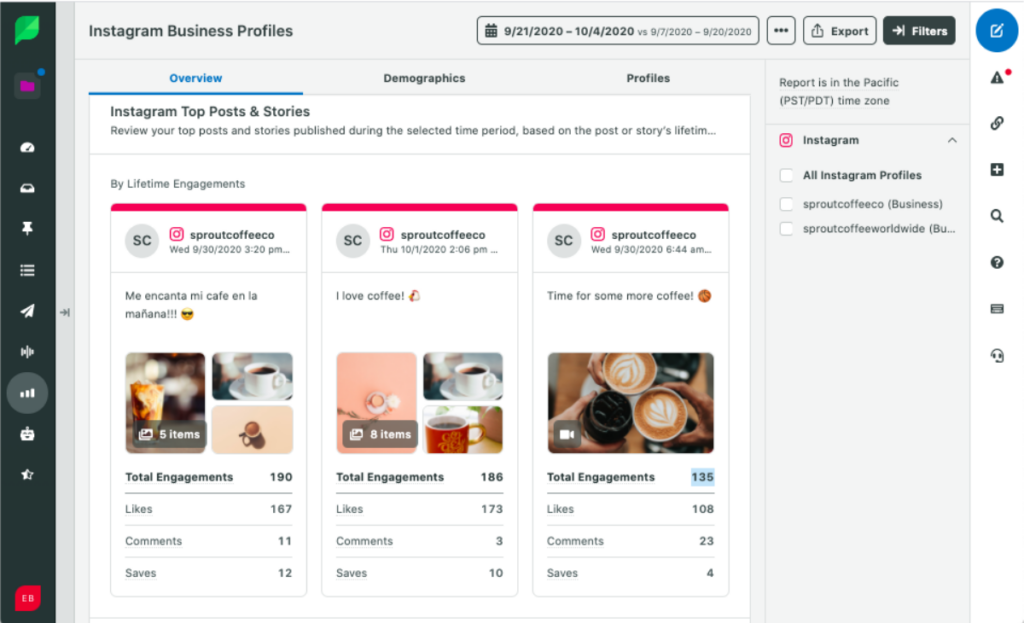
Pro tip: Another tactic is to do a search for your competitors by hashtag on Instagram, like #Folgers, to see how many people are tagging your competitors in posts. If it’s a lot, that’s an indication the company is getting noticed and has an active following.
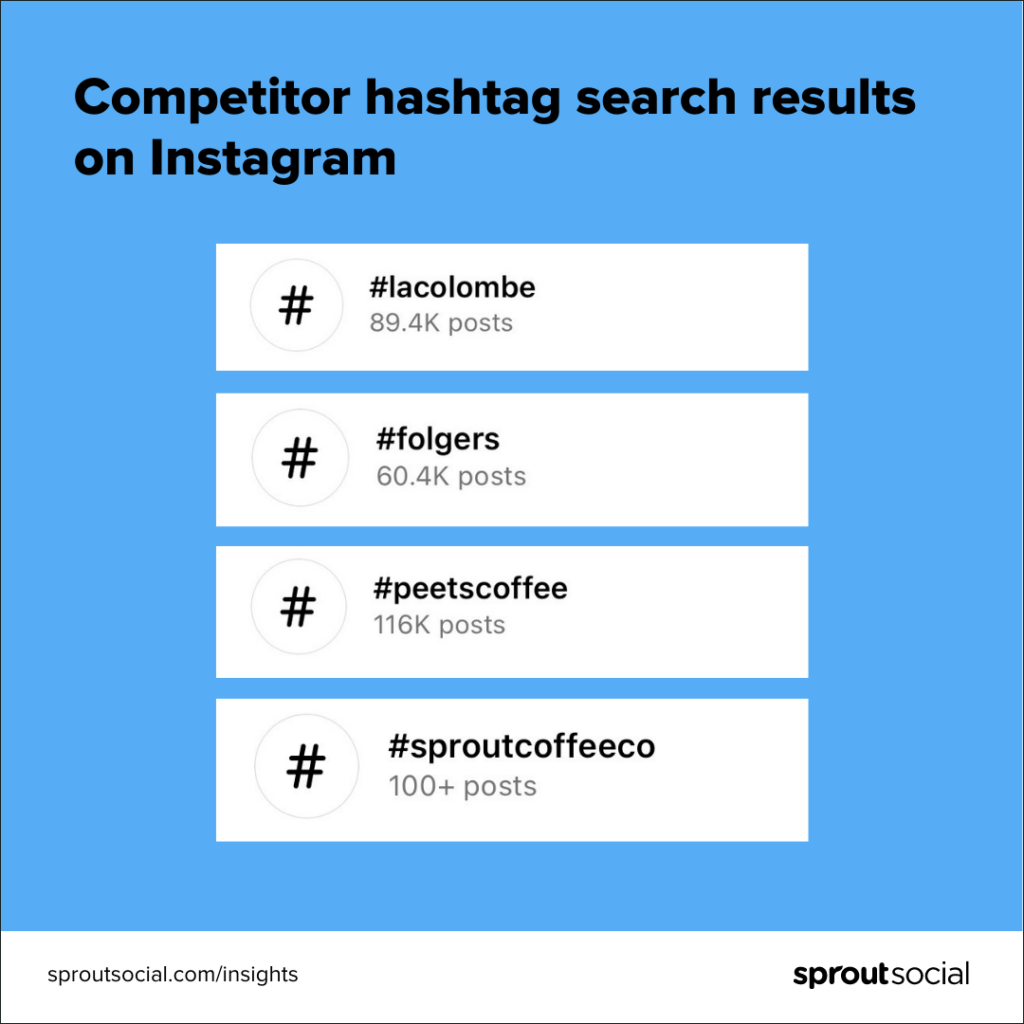
This will also give you a sense of what hashtags people use to refer to other brands and could potentially spark ideas for hashtags to use for your brand.

Once you have all the information from your Instagram competitive analysis research, make sure you add that data to your spreadsheet, like so:

Facebook competitive analysis
Start by doing a manual review of your competitor’s page, looking for the basics:
- Number of follows and page likes
- Any specific tabs or features they have. For example, some coffee roasters might have the shop section enabled. If we notice the same trend with other competitors, it’s likely a good sign it’s working for them.
- Look at their visuals and branding.
- Review their About section—how do they set their business and social presence apart?
A visual analysis is nice, but it only goes so deep. This is where Sprout’s Facebook Competitor Report comes in to judge how well the competition’s content performs over time.
Use this report to see how many messages your competitors send and receive, the types of content they post (text, images or videos), engagement and the amount of received messages. All of which answers higher-level questions about your competition’s presence, and how you can stand out from it.

Include this in your spreadsheet, as well as any specific metrics that are important to your strategy.
Twitter competitive analysis
Your Twitter analysis will look similar to your Facebook analysis.
Here are a few areas to take note of:
- Number of followers.
- Look at the visuals and branding of their cover image and profile picture. How often do they shift these visuals?
- Review their bio—what are they highlighting? How have they set themselves apart?
- Do they adjust their Twitter name (not their handle) for holidays like Halloween?
To see a more direct, automatic comparison between your Twitter account and your competitors, level up with Sprout’s Twitter analytics. This compares your Twitter profiles against each other, or a competitor. Select your Twitter account, then enter a competitor for the other slot.
The report shows engagement, influence, followers gained/lost and mentions. You can change the time period, but it’s best to stick to the last 30 days to keep the data relevant.

Once you’ve looked over all the competitive social media analysis from the Twitter report, be sure to enter the data into your spreadsheet. Tracking this information can be extremely valuable down the line.

Level up your data
Our spreadsheet and Sprout’s reports include Facebook, Twitter and Instagram.
But we recommend conducting a manual analysis of any additional platforms, like LinkedIn and TikTok, that are relevant to your brand and audience.
Also explore Sprout’s new competitor widgets available in the Professional and Advanced plans. These enable you to customize reports and include your data alongside competitor data in one, singular report.

3. Analyze competitors
Half of competitive intelligence is quantitative. But to get a true 360 view of your competitors’ social channels, you’ll need qualitative data on how your competitors use each platform.
Start analyzing your competitors’ social strategy by focusing on these three questions:
- How active is the competition?
- What types of content do they publish?
- What’s their brand’s social persona?
How active is the competition?
It’s fairly easy to gauge how active brands are by answering these questions:
- When was the last time they posted?
- Are there long spans of time between each post?
- Do they respond to comments?
- How in-depth are their responses to comments?
Brands should post at least once every couple of days to be considered active. But if your competitors post several times a day more than you, you risk falling behind. For example, Twitter allows for a lot more flexibility when it comes to how often to post—are your competitors significantly outpacing your daily Tweets?
Looking into all of this sheds light on their content strategy and customer care strategy—and where there are gaps.
What types of content do they post?
According to a Q1 2023 Sprout pulse survey, 53% cited changing content formats as a major challenge when planning and scheduling content.

Look at each competitor’s last 10 posts and calculate what percentage of them are promotional—prompt their audience to sign up, shop, etc.
This can also apply to the content formats they post. Are they posting a lot of video content? Mainly photos? Do they lean heavily on creators and user-generated content? How often do they jump on trending sounds or social media memes?
Use this information to see what content formats they’re using to pull ahead to cut the guesswork out of your strategy.
What’s their brand persona?
Some marketers like to look at their competitor’s brand voice when doing a social media analysis. Voice describes the tone and POV a brand uses on social media. Do they post from the brand’s perspective (we) or do they let individuals post on the brand’s behalf.
For example, the tone of the Field Museum’s social account…
Clawing my way to the weekend. 💀 pic.twitter.com/Y1keGLFwB8
— Field Museum (@FieldMuseum) January 27, 2023
…is very different from the American Museum of Natural History’s tone. They each have their own online personalities .
It’s #FossilFriday! Let’s swim back in time some 85 million years ago to the Late Cretaceous to meet Xiphactinus, a gigantic predatory fish. This species, which could reach lengths of 17 feet (5.2 meters), was capable of swallowing a 6-foot- (2-meter-) fish whole! pic.twitter.com/71JD3k1B5J
— American Museum of Natural History (@AMNH) January 27, 2023
Level up: As you wrap up, take a look at your competitors’ websites, because content marketing and social media are closely related. A lot of companies repurpose their blogs for social media content. Take a look at your competition and see how many of them maximizing their bevy of content
Once you’ve gone through each competitor, say it with me: Put the data into your social media competitive analysis template.
4. Step up your social media competitive analysis with listening
If you’re new to social media competitive analysis, starting with our template will help you get familiar with your competitors’ social media performance and uncover patterns for you to tune into.
But if you’re ready to take your competitive analysis on social media a step further, tap into social listening. Social listening gives you a broader perspective of conversations related to your industry and competitors that are happening across social—even when you’re not tagged. Combined with Sprout’s network competitor reports, social listening expands your view and brings in conversations on YouTube, Reddit and the broader web.
It’s an invaluable tool to uncover gaps that you can fill, conversations to jump into and more. For example, Grammarly uses Sprout’s social listening tools to provide cross-team insights and analyze their competitive share of voice on social. In 2021, Sprout helped them identify that their brand owned 71% of their competitive share of voice.
Sprout’s built-in competitive analysis tools also make it easy to measure your competitors’ social presence and compare it to yours.

With this template, you can identify the top competitors you want to track and include specific profiles, keywords, phrases and hashtags that you want Sprout to listen to.
To see what Sprout’s social listening tools can do for your brand, request a demo to try it for yourself.
5. Using your social media competitive analysis template and data
Now that you’ve compiled all of this data, you need to put it to use. Using your brand’s social media analytics, you can compare your profiles to the competition. That’s why we included a line for your company’s data into our template.
Your final step is to interpret the data into something others will understand by going beyond simply sharing your filled-out template. With data storytelling, turn those raw numbers and insights into digestible and actionable takeaways.
Here are a few tips:
- Use visuals. Data visualizations, like the charts and graphs Sprout reports provide, break down data into digestible visuals.
- Identify the most interesting points and findings. Most don’t need (or want) to see every detail. What are the key findings from your social media competitive analysis?
- Predict questions or challenges. Get ahead by providing solutions and answers.
- Provide next steps. Doing a competitive analysis of social media is one thing. But defining the “what now?” is the whole reason for doing so. With what you’ve discovered, what are your next steps to improve your content and share of voice?
It’s important to keep in mind that this social media competitive analysis isn’t for you to copy exactly what everyone is doing. Instead, it will guide you toward getting started on the right foot.
Dive into the data with a social media competitive analysis
In the end, it’s all about comparing your brand’s metrics and data to the competition. Then make any necessary adjustments to get a leg up on your competitors.
You have the template. Now, make your social media competitive analysis less daunting and more automated by adding Sprout to your toolbox—try Sprout free for 30 days and learn how our competitive analysis reports will help you uncover deeper insights to optimize your strategy.
- Categories
How to build a competitive analysis report with examples and tools
Published on March 7, 2024 Reading time 8 minutes - Categories
Business intelligence reporting: making sense of your organization’s data
Published on February 21, 2024 Reading time 8 minutes - Categories
Competitor mapping: The benefits and how to create your own
Published on February 8, 2024 Reading time 5 minutes - Categories
12 of the best competitive intelligence tools for marketers
Published on February 7, 2024 Reading time 7 minutes




Share